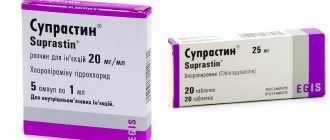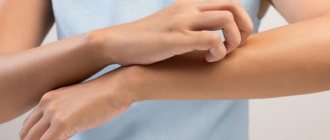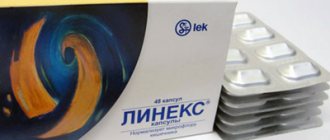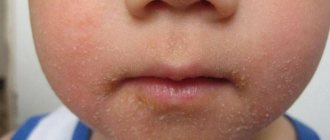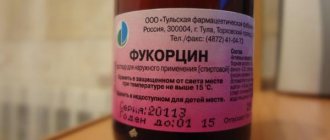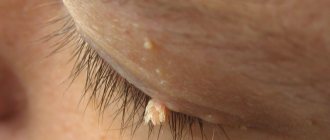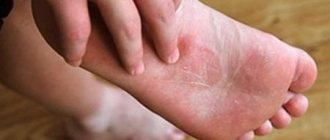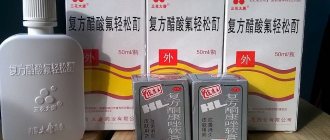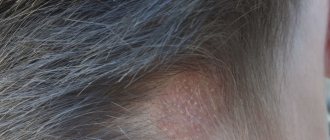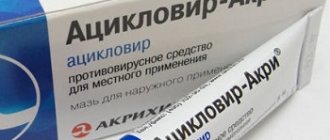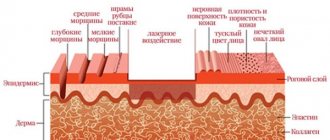If you notice redness, rashes and swelling of the skin, then you need to contact an allergist so that he can prescribe you antihistamines for skin allergies.
An allergy is an increased reaction of our body to certain environmental factors: medications, pollen, household chemicals, dust and others.
This reaction manifests itself as itching of the skin, redness, rash and swelling, conjunctivitis of the eyes, lacrimation, allergic rhinitis and cough.
Skin rashes on the arms, legs, body and face are well treated with many antihistamines for skin allergies, cheap domestic ones and expensive imported ones.
Allergic dermatosis (skin reaction) is most often treated with drugs in tablets, because external manifestations on the skin are provoked by internal changes.
In this article, we will look at which antihistamine is better, which modern medicine against skin rashes helps well and will not cause severe side effects, and we will find out a list of inexpensive analogues and generics.
Signs of skin allergies
The main causes that cause allergic skin rashes are:
- Allergenic products (honey, citrus fruits, nuts, strawberries, seafood, full-fat milk).
- pollen of flowers, trees.
- dust (home and street).
- animal waste products (feathers, wool, saliva, fluff, excrement).
- household chemicals (cleaning products, washing powder with chlorine, phthalates and phosphates).
- chemicals (varnishes, paints).
- medications (usually analgesics, antibiotics, vitamin B).
- frost, strong wind, sun.
Manifestations on the skin can be mild (rash, swelling and redness are observed in individual areas of the skin) and severe (large areas of the skin are affected: blisters, rash, severe itching, hyperemia). If the manifestation is mild, taking one tablet removes all negative symptoms.
IMPORTANT! If the cause of skin rashes is not eliminated, then effective treatment is impossible in principle. For example, in case of food allergies, you need to remove those foods that provoke an increased reaction in the body. If you do not identify the cause and do not get rid of it, then even increasing the dose of anti-allergy medication will not be able to cope with the symptoms.
If the symptoms manifest themselves clearly, then you need to take a good antiallergic drug that works comprehensively on all symptoms, and not just on the skin.
Combined method of drug treatment
Combined method of treating allergies
There is no ideal treatment system that can help everyone recover quickly and easily in one go, but there is a way to increase the chances of recovery.
Based on the studies conducted, it can be concluded that a favorable outcome is achieved through therapy. It is not always possible to cope with an illness with the help of one remedy; you have to take it in combination with another drug. As practice shows, combining antihistamines with adsorbents helps achieve the desired result.
Activated carbon is used together with Zyrtec and Telfast; this combination is suitable for a fragile child’s body. Combined treatment helps eliminate food allergies and helps strengthen the immune system.
There are specific cases when the attending physician prescribes Duphalac, a laxative that removes toxins, and in addition to it, adsorbents such as Polysorb and Enterosgel are prescribed.
It is not recommended to combine drugs with each other, relying solely on your own conclusions, because the wrong combination and inattentive study of the instructions will not only lead to complications, thereby worsening your well-being and to death.
Self-medication can be harmful to your health; trust an experienced doctor who can establish a diagnosis and prescribe safe and effective treatment for drug allergies.
It will not be possible to limit yourself to just a few preventive sessions, since there is no universal panacea for diseases. You should take the courses of therapy seriously, trying not to interrupt them, because this will only complicate the course of the allergy. Therefore, patients should prepare for long-term, and in special cases, permanent treatment.
The necessary technique for each patient is determined individually; it is prescribed by an allergist, and in rare cases, by an immunologist. If you follow the recommendations of specialists, there is a high probability of either reducing the number of symptoms of the disease or recovering from it.
List of antihistamines for skin allergies
If you have a skin reaction to an allergen, then you cannot independently compile a list and prices of medications in alphabetical order that help with allergic rashes and which you should try on yourself. You should contact specialists.
Article on the topic: Treatment of facial allergies with folk remedies
At an appointment with an allergist or dermatologist, patients ask: “Please advise which antiallergic medications to take? Tell me the names of effective antiallergic drugs for itchy skin?”
List of medications for skin allergies
The doctor will not recommend the first thing he comes across; he can help an allergy sufferer when he conducts a comprehensive examination.
The doctor is obliged to talk with the allergy sufferer, find out about other diseases, drug intolerances, and be sure to conduct an examination to determine the cause of the disease.
Only after this can the doctor tell you the name of the antihistamine that can help in the treatment of skin allergies, the most powerful in a particular case.
Despite the fact that allergic dermatosis manifests itself externally, it is necessary to treat it from the inside.
Why is this important to know? Because you need to choose the right dosage form of the drug, that is, use primarily not external medications (cream, ointment), but drugs in the form of tablets, drops and solutions.
Itching due to skin allergies
The choice of medications for skin allergies today is huge: there are good Russian medications known since Soviet times, as well as modern anti-allergy drugs that do not cause drowsiness.
Further in the article we will analyze the most famous allergy pills and make a small rating of the best for adults and children.
All antihistamines prevent the production of histamine and block the development of the following symptoms: redness, itching, swelling of the skin, and also normalize the patient’s blood pressure and breathing: they block spasms in the bronchi and laryngeal swelling. A sign of a strong remedy is also a decrease in lacrimation and redness of the whites of the eyes and eyelids, the disappearance of allergic cough and runny nose.
1st generation antihistamines
The first generation of antihistamines are very rarely prescribed nowadays. They have a number of common features: the drugs are inexpensive, but cause side effects that seriously affect the allergy sufferer’s body and his lifestyle.
Common features of this group of antihistamines:
- Low cost (the main price tag most often does not exceed 300 rubles);
- A short-term effect (you need to drink them several times in one day) and quick addiction (they need to be alternated with other medications from this group every couple of weeks).
Symptoms of using first generation antihistamines:
- increased heart rate (tachycardia).
- constipation.
- blurred vision.
- depressed state of the nervous system (the appearance of drowsiness and a decrease in the speed of reaction to environmental factors (decreased concentration of attention)).
1st generation antihistamines
All these side effects complicate the patient’s existing lifestyle and daily routine. These antihistamines can make a person less mobile.
Antihistamine drugs from this group are not popular, except for Suprastin, a cheap drug from the list of essential drugs, established by law as vital. It is better to take these drugs for adults, as they have less side effects. Let's look at them in a table that shows their differences.
| Name | Active substance | Features of the drug | Average price, rub |
| Suprastin | Chloropyramine | Does not cause serious cardiac toxicity | 128 |
| Tavegil | Clemastine | There are serious allergic reactions to the components | 159 |
| Diphenhydramine | Diphenhydramine | Strong effect on the central nervous system | 75 |
| Diazolin | Mebhydrolin | Negative effect on the gastrointestinal tract | 69 |
| Peritol | Cyproheptadine | Increases appetite, appearance of photosensitivity | 2400 |
| Pipolfen | Promethazine | Reduced intestinal motility, for children from 2 months | 277 |
| Diprazine | Promethazine | Active effect on the nervous system | 1100 |
| Fenkarol | Hifenadine | Weak efficiency | 350 |
We do not recommend taking these antihistamines due to the huge number of contraindications and serious side effects, but you need to know what they are called.
Antihistamines 2nd generation
For allergic rashes, they often take second-generation antiallergic drugs; they are universal (prescribed for many types of allergies). They are not addictive, do not affect the nervous system, which means there will be no drowsiness or lethargy.
Antihistamines 2nd generation
| Name | Active substance | Features of the drug | Average price, rub. |
| Claritin | Loratadine | It is prescribed to children over the age of one year and the elderly, there are almost no side effects. | 174 |
| Semprex | Akrivastine | Has a short duration of action, but the medicine is safe | 110 |
| Trexil | Terfenadine | The first drug of the 2nd generation, depresses the cardiac system. It's inexpensive. | 97 |
| Fenistil | Dimetindene maleate | Tablets, gel. Popular remedy. | 319 |
| Gistalong | Astemizole | Effective for chronic allergies. | No information, because it has not been present on the market for a long time |
Claritin is most often prescribed from this list, because it is believed that this drug is safe. But it can be replaced with a domestic, inexpensive analogue with a similar active substance, which gave it its trade name (“Loratadine”). The price of the latter is much lower. Loratadine is used in the treatment of children, replacing the first generation drug Ketotifen, which is inexpensive but has a large number of side effects.
These antihistamines are easy to use: the effect lasts up to 12 hours and you can take them 1-2 times a day. But these drugs can cause a negative effect in adults and children with heart disease, so they are contraindicated for such patients.
Antihistamines 3rd generation
The next group of drugs are drugs with anti-allergic effects of the third generation, whose active components are metabolites of the active substances of drugs of the second generation.
Antihistamines 3rd generation
These antihistamines are new and appeared in pharmacies relatively recently. They do not affect the nervous and cardiac systems and are indicated for a wide range of patients: from young children to the elderly. In adults working in areas where concentration is required, such antihistamines will not cause negative effects. So doctors recommend that they take these medications.
| Name | Active substance | Features of the drug | Average price, rub. |
| Telfast | Fexofenadine | It is not metabolized in the body and is prohibited for children under 6 years of age. French drug | 570 |
| Fexofenadine | Cheap analogue of Telfast. | 281 | |
| Cetirizine | Cetirizine | Strongest for skin allergies. | 105 |
| Zyrtec | Effective for skin dermatoses, lasts for 24 hours | 199 | |
| Tsetrin | Prescribed to children from 6 months. | 164 | |
| Fexadine | Fexofenadine | It has an analogue sold abroad - Fenafex. No addiction after a month of use | 350 |
| Allergofree | Levocetirizine | Antiallergic effect lasts 2 days, produced in Kazakhstan | Sold in Kazakhstan for 1224 tenge (211 rubles) |
| Erius | Desloratadine | Acts on the periphery of histamine receptors, a good drug for chronic urticaria. | 600 |
The question of whether the new generation antiallergic drug Erius is a hormonal drug or not often arises among patients. The answer is no. Erius is an antihistamine with the active ingredient desloratadine, a metabolite of loratadine. This is the best drug according to many doctors and patients.
Classification of antiallergic drugs
Antihistamines are used for various diseases that occur as a result of allergies (allergic conjunctivitis, rhinitis, dermatitis, gastritis, as well as common urticaria). The advisability of their use in all these cases is due to the fact that histamine has a wide range of effects. The very first drugs that can effectively block human H1-histamine receptors, thereby preventing further progression of allergies, began to be used in clinical practice back in 1947.
Since the middle of the last century, all drugs that help fight the negative manifestations of allergic reactions have been modified several times. Scientists have been able to create more and more new drugs from this group. They are more effective, although they are analogues of the old ones. At the same time, they have a smaller list of side effects. The entire variety of antihistamines presented by the modern pharmaceutical industry is classified into several levels. They are divided into 3 generations, each of which has its own characteristics.
Immunomodulators for skin allergies
For people with skin allergies, taking immunomodulators is mandatory, especially for those who have chronic allergic dermatosis for stronger therapeutic therapy.
They are taken along with anti-allergen therapy all year round on an ongoing basis by those who have constant allergies. List of immunomodulators to drink for adults and children with skin allergies:
- Lycopid.
- Viferon.
- Derinat.
- Timolin.
- Immunofan.
The antihistamines listed above are not all anti-allergy drugs presented on pharmacy shelves. There are a huge number of them, which is very difficult to sort through. The main thing to remember is that a specialist should prescribe this or that drug.
Rules for using ointments for children
The child's body is exposed to a large number of influences. It has little protection, so even antihistamine ointments for children can cause harm. To reduce the negative impact and help the child as much as possible, a number of rules should be followed:
Start using the cream gradually, mixing it with baby or nourishing cream in the first days.- Use a small amount of cream for the first time; if there is a negative reaction, change the drug. This especially applies to hormonal drugs.
- After completing the course of treatment, use a moisturizer to reduce irritation.
- Before applying the ointment, rinse the area with cool or slightly warm water.
- The use of hormonal drugs for children under one year of age is not recommended at all.
The course of treatment prescribed by the doctor must always be completed in full. If you stop treatment early, the irritation may return and the medication will no longer work and will need to be changed. At some point, there will be no options left and treatment will become difficult.
Contraindications and side effects. Overdose
There is not a single medicine that does not have contraindications and side effects. One way or another, the use of drugs is an extraneous intervention in the body that can have undesirable consequences.
Contraindications
Contraindications to the use of each specific medicine, of course, differ, and it is necessary to consult a doctor and carefully study the instructions for each drug. However, there are common situations in which use is unacceptable:
- individual intolerance to the components of the drug;
- hypersensitivity to the components of the drug;
- severe pathology of the liver and kidneys;
- severe pathology of other internal organs;
- age (individually for each product);
- in some cases - lactase deficiency.
Side effects
Many parents are understandably interested in what is the effect of antihistamines on the child? Do they have adverse effects, are there any side effects? In terms of the number of side effects, first-generation drugs lead. Among the possible:
- drowsiness, weakness, decreased concentration, lack of attention;
- anxiety, insomnia;
- convulsions, dizziness, loss of consciousness;
- blurred vision;
- dyspnea;
- disturbance of urine outflow;
- swelling;
- anaphylactic shock, angioedema or other allergic reactions.
Second generation drugs have fewer undesirable effects, but they do exist:
- feeling of dry mouth, nausea, vomiting;
- abdominal pain;
- increased fatigue, increased excitability;
- tachycardia (extremely rare);
- allergic reactions.
During the development of third-generation drugs, numerous placebo-controlled studies were conducted that confirmed the effectiveness and safety of the drugs. However, can these drugs be harmful, and if so, why are antihistamines of this generation dangerous for children? May develop:
- headache, drowsiness, dizziness (less than 10%);
- insomnia, irritability, tachycardia, diarrhea (less than 1%)
- hypersensitivity reactions (<0.1%).
Precautionary measures
The main measure to prevent complications is not to prescribe medications yourself, but to take medications only on the recommendation of a doctor. In addition, you should consider:
- if long-term antihistamines are used for children, dosage adjustments must be made regularly;
- the possibility of drug interactions when using other drugs;
- inadmissibility of consuming even low-alcohol drinks together with antihistamine therapy (relevant for teenagers);
- the need for strict adherence to the doctor’s recommendations, dosage, frequency of administration.
